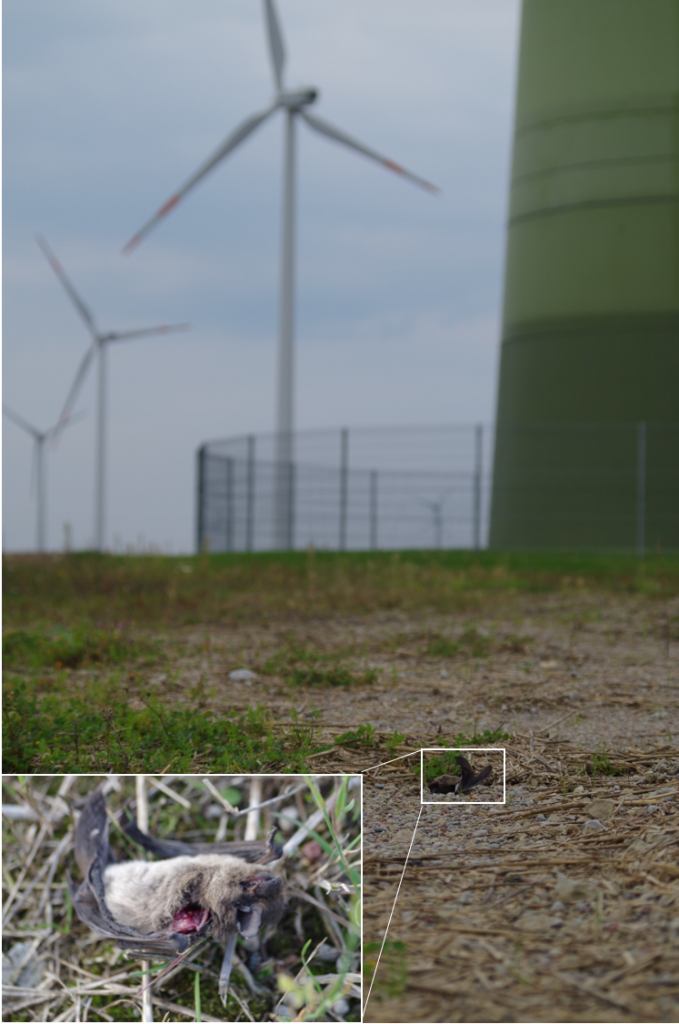Press release of the German Bat Observatory
Experts are raising the alarm – species protection is clearly being neglected in the legislative changes to the expansion of wind energy
Alarming statistics and urgent requests: the expansion of wind energy threatens to become a nightmare for our winged friends. Experts are raising the alarm and revealing the devastating effects that current legislative changes could have on bat populations. While the fight against climate change is gaining momentum, species protection is increasingly falling behind. But there are solutions, and we must act.
In a world full of environmental problems, climate change and the extinction of species are at the top of the agenda – we are aware of both problems. Unfortunately, however, there are often conflicts between climate protection measures and the protection of biodiversity. One such example is the expansion of wind energy, which often results in bird and bat fatalities. Our aim is therefore to find solutions that ensure the protection of bats during the expansion of wind energy. We are convinced that an energy transition is possible taking species protection seriously and offering effective solutions.
There are around 25 bat species in Germany, some of which, such as the Noctule Bat or Nathusius’ Pipistrelle Bat, are particularly common victims of wind farms. In addition, many other species are disturbed in their habitats by the expansion of wind turbines in forests, as their roosts and foraging habitats disappear.
The latest legislative changes further exacerbate the problem by facilitating the expansion of wind energy at the expense of nature. In a scientific study, experts from the German Bat Observatory and other experts in the field of wind power and species conservation have analysed the current legislative changes and scientific studies and proposed measures to limit the damage to bat populations.
What is particularly worrying from a species conservation perspective is that even landscape conservation areas are now being used for the construction of new wind farms without the need for species conservation surveys, meaning that wind turbine sites are no longer being checked in advance for the presence of bats (or birds), which has been standard practice for decades. This is particularly alarming as around 250.000 bats are killed every year because many turbines do not yet have curtailment-algorithms or the existing curtailment-periods are not monitored by the conservation authorities.
In our study, we summarise the most important conflicts between wind farms and bats in Germany and propose constructive solutions. Among other things, we call for sufficient curtailment-periods at all wind turbines and a limit on the acceptable loss of bats to less than one individual per turbine per year. We are also in favour of keeping forests and protected landscape areas free of wind turbines and maintaining minimum distances from protected areas and roosts.
As a collective of experts, we know that climate protection is important and we emphasise that we support the use of renewable energies. However, we cannot accept that this continues to happen at the expense of nature, which is already suffering from numerous other threats. We therefore call for a species-friendly energy transition that also takes into account the needs of bats and other animals and protects their habitats.
German Bat Observatory
Study:
Mathgen, X., Fritzsche, A., Arnold, A., Bach, L., Gager, Y., Harder, J., Knörnschild, M., Meyer, F., Porschien, B., Seebens-Hoyer, A., Starik, N., Straka, T., Fritze, M. (2024): Zeitenwende im Artenschutz – Aktuelle Gesetzesänderung versus wissenschaftliche Evidenzen beim Fledermausschutz und dem Ausbau der Windenergienutzung. Nyctalus 20 (3-4), pp. 182-202. OPEN ACCESS DOWNLOAD

